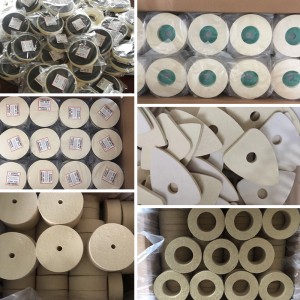In the global wool felt wheel industry, standardization efforts are gaining momentum as a crucial step towards ensuring product quality, promoting fair competition, and facilitating international trade. As the demand for wool felt wheels continues to grow across various industries, the need for clear and consistent standards has become increasingly evident.
One of the primary goals of standardization in the wool felt wheel industry is to define product specifications. This includes parameters such as wheel size, density, hardness, and fiber composition. By establishing uniform standards for these characteristics, manufacturers can ensure that their products meet the expectations of customers and are compatible with different polishing equipment and compounds. For example, a standard for wool felt wheel diameter and thickness would make it easier for users to select the right wheel for their specific applications, reducing the risk of using an inappropriate product that could lead to poor results or equipment damage.
Quality control is another area where standardization plays a vital role. Standardized testing methods are being developed to assess the performance and durability of wool felt wheels. These tests can evaluate factors such as the wheel’s ability to remove scratches, its resistance to wear and tear, and its compatibility with different polishing compounds. By adhering to these testing standards, manufacturers can ensure that their products are of high quality and consistent in performance. This not only benefits end – users by providing them with reliable products but also helps to build trust in the industry as a whole.
Standardization also has implications for international trade. In a globalized market, having common standards makes it easier for wool felt wheel manufacturers to export their products to different countries. It reduces the complexity of compliance with various national and regional regulations, facilitating smoother trade flows. For example, if there is an international standard for wool felt wheel safety, manufacturers can ensure that their products meet this standard and gain access to multiple markets without having to comply with a multitude of different safety requirements.
Industry associations and international organizations are at the forefront of these standardization efforts. They bring together manufacturers, suppliers, end – users, and experts to develop and update standards. These groups conduct research, consult with stakeholders, and engage in extensive discussions to reach consensus on the best practices and requirements for the wool felt wheel industry. The development of standards is a collaborative process that takes into account the diverse needs and perspectives of all parties involved.
However, implementing standardization is not without its challenges. One of the main obstacles is getting all industry players to adopt and comply with the new standards. Some smaller manufacturers may face difficulties in meeting the requirements due to resource constraints, while there may also be resistance from those who are accustomed to existing practices. To overcome these challenges, education and training programs are being developed to help manufacturers understand the benefits of standardization and how to comply with the new standards.
As the standardization efforts in the wool felt wheel industry progress, the future looks promising. Clearer standards will lead to higher – quality products, increased customer satisfaction, and a more competitive and sustainable industry. With continued collaboration and commitment from all stakeholders, the wool felt wheel industry is set to reap the rewards of a well – defined and standardized marketplace.

Post time: Jun-09-2025
